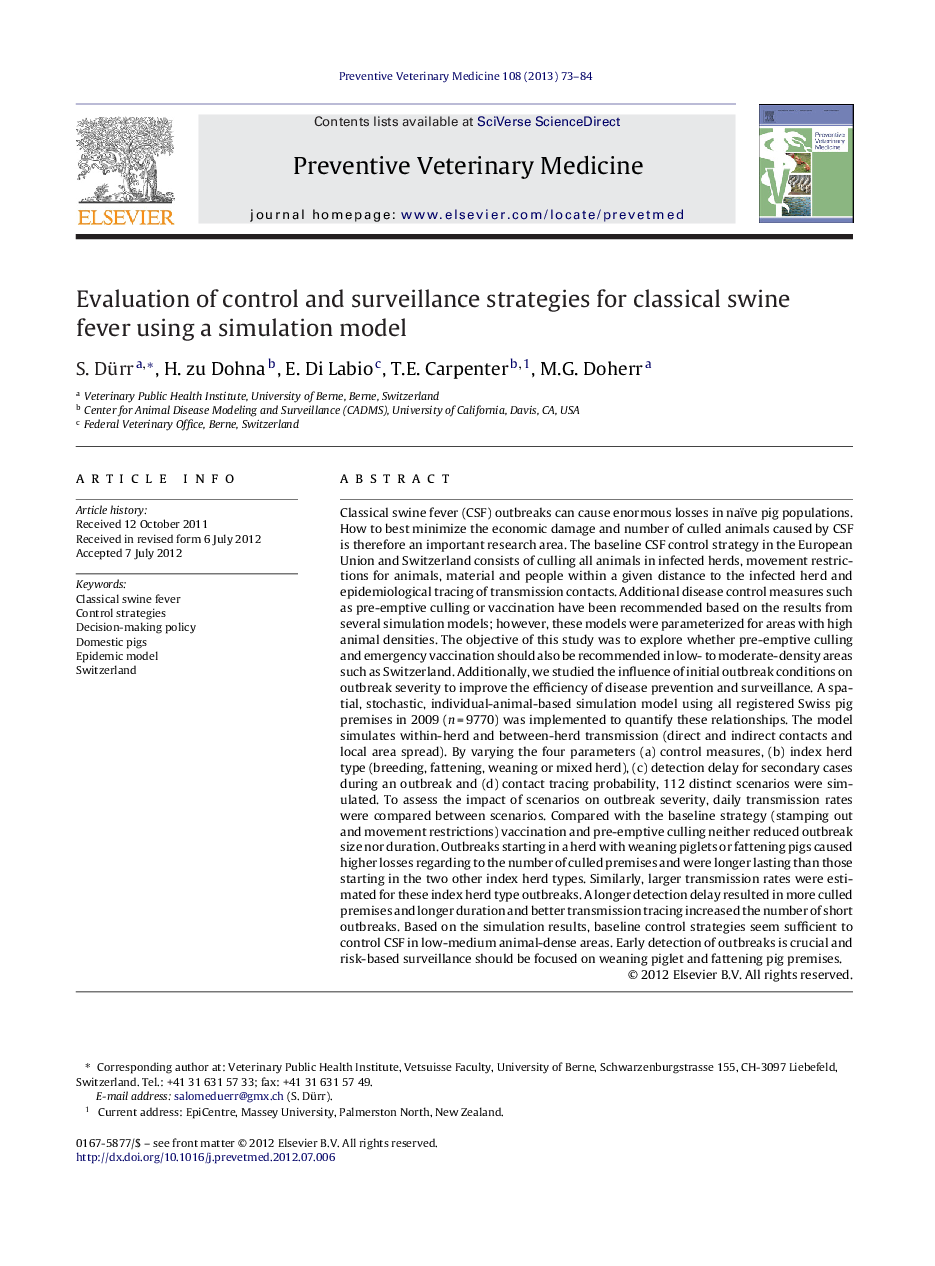| کد مقاله | کد نشریه | سال انتشار | مقاله انگلیسی | نسخه تمام متن |
|---|---|---|---|---|
| 5794022 | 1110042 | 2013 | 12 صفحه PDF | دانلود رایگان |
عنوان انگلیسی مقاله ISI
Evaluation of control and surveillance strategies for classical swine fever using a simulation model
ترجمه فارسی عنوان
ارزیابی راهکارهای کنترل و نظارت تب کلاسیک با استفاده از یک مدل شبیه سازی
دانلود مقاله + سفارش ترجمه
دانلود مقاله ISI انگلیسی
رایگان برای ایرانیان
کلمات کلیدی
تب کلاسیک، استراتژی های کنترل، سیاست تصمیم گیری، خوک های خانگی، مدل اپیدمی، سوئیس،
موضوعات مرتبط
علوم زیستی و بیوفناوری
علوم کشاورزی و بیولوژیک
علوم دامی و جانورشناسی
چکیده انگلیسی
Classical swine fever (CSF) outbreaks can cause enormous losses in naïve pig populations. How to best minimize the economic damage and number of culled animals caused by CSF is therefore an important research area. The baseline CSF control strategy in the European Union and Switzerland consists of culling all animals in infected herds, movement restrictions for animals, material and people within a given distance to the infected herd and epidemiological tracing of transmission contacts. Additional disease control measures such as pre-emptive culling or vaccination have been recommended based on the results from several simulation models; however, these models were parameterized for areas with high animal densities. The objective of this study was to explore whether pre-emptive culling and emergency vaccination should also be recommended in low- to moderate-density areas such as Switzerland. Additionally, we studied the influence of initial outbreak conditions on outbreak severity to improve the efficiency of disease prevention and surveillance. A spatial, stochastic, individual-animal-based simulation model using all registered Swiss pig premises in 2009 (n = 9770) was implemented to quantify these relationships. The model simulates within-herd and between-herd transmission (direct and indirect contacts and local area spread). By varying the four parameters (a) control measures, (b) index herd type (breeding, fattening, weaning or mixed herd), (c) detection delay for secondary cases during an outbreak and (d) contact tracing probability, 112 distinct scenarios were simulated. To assess the impact of scenarios on outbreak severity, daily transmission rates were compared between scenarios. Compared with the baseline strategy (stamping out and movement restrictions) vaccination and pre-emptive culling neither reduced outbreak size nor duration. Outbreaks starting in a herd with weaning piglets or fattening pigs caused higher losses regarding to the number of culled premises and were longer lasting than those starting in the two other index herd types. Similarly, larger transmission rates were estimated for these index herd type outbreaks. A longer detection delay resulted in more culled premises and longer duration and better transmission tracing increased the number of short outbreaks. Based on the simulation results, baseline control strategies seem sufficient to control CSF in low-medium animal-dense areas. Early detection of outbreaks is crucial and risk-based surveillance should be focused on weaning piglet and fattening pig premises.
ناشر
Database: Elsevier - ScienceDirect (ساینس دایرکت)
Journal: Preventive Veterinary Medicine - Volume 108, Issue 1, 1 January 2013, Pages 73-84
Journal: Preventive Veterinary Medicine - Volume 108, Issue 1, 1 January 2013, Pages 73-84
نویسندگان
S. Dürr, H. zu Dohna, E. Di Labio, T.E. Carpenter, M.G. Doherr,
